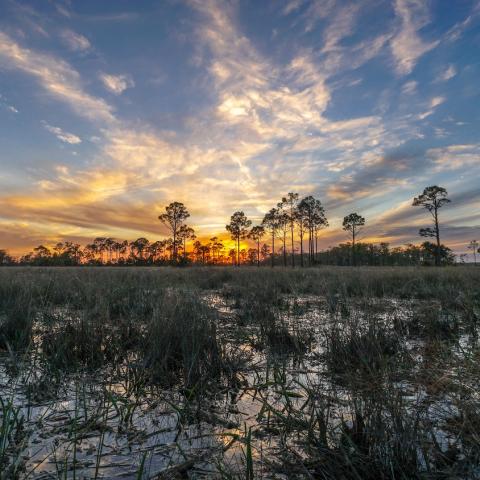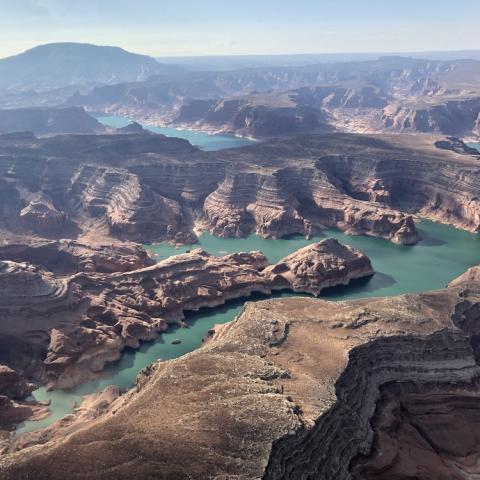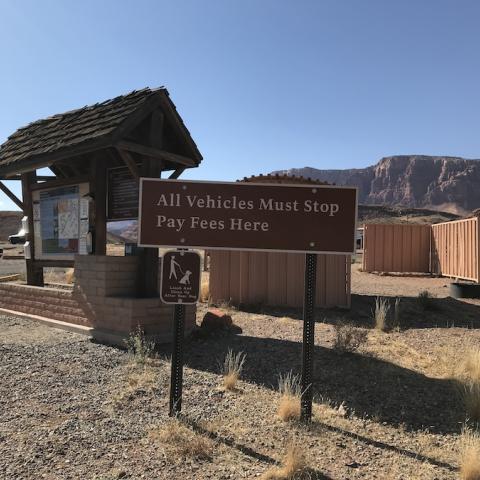Editor's note: This is the final article in a National Parks Traveler series on how the long-running drought in the Southwest is impacting units of the National Park System.
Gregor Schuurman started his career studying insects.
Then, “The demon climate change comes along,” he says, and everything changed.
“Very quickly, over the space of a few years, my life became more and more about thinking about climate change. Now, my focus is entirely on climate change,” he added.
As it has done to many concerned scientists, climate change compelled Schuurman to alter his career approach. A terrestrial ecologist turned conservation professor, he went from examining tiny invertebrates to thinking about massive ecological systems.
Today, Schuurman helps the National Park Service Climate Change Response Program plan for what the agency expects to be a future in which droughts, wildfires, floods, and other natural hazards become more likely and more severe due to climate change.
Omens of that future appeared this summer in the forms of record-setting droughts, heat waves, and wildfires, the effects of which have been explored in previous installments in this series.
This final article in our series on drought and its impacts looks at how the Park Service is preparing for similar or worse climate challenges in upcoming decades.
Planning For Change
Established in 2010, the National Park Service Climate Change Response Program advances efforts to address the effects of climate change across the National Park System. The program produces research reports, provides NPS training on climate literacy, develops frameworks for planning and adapting to climate change, and helps make climate science useful to park managers.
“Broadly, it's about helping parks and partners understand and respond to climate change,” Schuurman said.
But, sometimes the right responses are difficult to foresee because climate change is highly unpredictable, according to Bob Krumenaker, superintendent of Big Bend National Park.
“The problem with the range of climate change projections is they're not predictions; they are a range of possible futures,” Krumenaker said. “The general public wants scientists to predict a specific future, and that is impossible for almost anything. But it's particularly impossible when it comes to climate because of, first of all, the natural variability in climate. And, secondly, the evidence is very clear that what humans do in terms of our own emissions has a direct impact on the climate. We don't know what we're going to do, so we don't know what impact we will have.”
To address uncertainty, the CCRP develops scenario planning exercises that assess risks associated with discrete climate outcomes. By building scenarios based on projected future climate trends, managers can compare relative risk, test important decisions, and develop strategies and indicators that can assist in signaling key changes in an ecosystem, the NPS says.
For example, a recent scenario planning guide on White Sands National Park considers three “divergent but plausible” climates that could appear in the park by 2055: 1.) Warm/No Precipitation Change, 2.) Hot and Wet, and 3.) Hot and Dry.
At a summer conference to discuss the scenarios, park staff discussed what each outcome could mean for animals, from desert bighorn sheep to nematodes, as well as hydrological systems, dust emissions, and plant life. White Sands ecologist David Bustos, a participant, said the exercise helps managers evaluate the likelihood of each outcome and their associated impacts on ecology to get a better overall understanding of what the future might hold.
“I think scenario planning is important [...] because we can start to see what possibilities are out there,” Bustos said. “We can have an idea [about] what direction we’re going and how to plan as we do see changes.”
The 'Fat Tails' Of Extreme Weather
Although scientists cannot pinpoint what average regional climates will be like in the future, they agree that warming temperatures will lead to more extreme weather events, a hypothesis backed by the most recent report from the Intergovernmental Panel on Climate Change.
“There is strong evidence that characteristics of many individual extreme events have already changed because of human-driven changes to the climate system,” the report reads. “Some types of highly impactful extreme weather events have occurred more often and have become more severe due to these human influences. As the climate continues to warm, the observed changes in the probability and/or magnitude of some extreme weather events will continue as the human influences on these events increase.”
A 2021 NPS report assessing climate change in the parks warns that there will likely be more extreme weather events in many national parks in the future.
On the one hand, the report predicts that rising temperatures in most parks could exacerbate droughts, increase the durations between precipitation events, and threaten water availability for ecological and human uses. On the other hand, the report says that warming temperatures might also cause paradoxical effects — increasing the likelihood of more frequent and severe flooding due to heavy precipitation events and storm surges.
Schuurman calls these opposite and drastic events “fat tails.” It’s a popular term used in finance, mathematics, and physical sciences to describe extreme events that are more likely to occur than what would normally be expected.
If you imagine a bell curve where the peak represents average precipitation, the tail ends of the curve would represent extreme flooding and extreme drought. Under normal climates, the extreme events — flooding and drought — would be unlikely to transpire. However, scientists say climate change has shifted the bell curve, making extremes more probable, or, in math speak, creating fat tails.
Debra Hughson, the science advisor at Mojave National Preserve, says “fat tail” precipitation events at her park seem to be happening more frequently this century than historical data would have predicted.
While it’s true that the Mojave Desert has seen below-average precipitation since the start of the 21st century, Hughson says calling the trend a megadrought only tells part of the story. Periodic monsoonal rain storms cause flash floods, including one this summer that inundated much of the preserve and wiped out the park's roads.
“The story of precipitation in this part of the world is a complicated story,” Hughson said. “It has a little bit to do with the drought, but mostly, in my opinion, with the variability in precipitation.”
Grappling With 'Natural' Processes In The 21st Century
More variability means more uncertainty, something Schuurman says park managers will need to embrace and prepare for by being forward-looking and using scenario planning and other frameworks.
Schuurman says park managers generally have three options to deal with climate change: resist, accept, or direct.
For decades, the NPS has worked under a dictum to resist change in order to maintain conditions in the parks as closely as possible to those which historically occurred “in the absence of human dominance over the landscape.”
While that remains an important tenet of the agency, it is now widely understood that maintaining historical conditions in every situation can be infeasible or even impossible to do in the face of climate change.
The RAD (Resist-Accept-Direct) decision framework has emerged over the past decade as part of a “new management paradigm” that recognizes that change is inherent in natural systems, according to the NPS.
“If we can't resist unnatural anthropogenic change, then we want to at least try to fend off some of the worst case outcomes,” Schuurman said.
But accepting climate change could mean standing by as beloved and ecologically critical species are pushed onto ecological islands in the parks or go extinct and park landscapes transform beyond the recognizable.
“Accepting change is a choice, and it might be a very consequential one,” Schuurman said. “Doing nothing needs to be examined under the same kind of lens as some fairly radical interventions.”
In its own right, directing change by actively shaping ecosystems can get “pretty funky,” the scientist added.
It includes strategies such as managed relocation, basically moving plant and animal species to nonnative environments — often northward or to higher elevations — because their natural environments are or will soon experience a hotter, drier climate that is not suitable for their survival, according to the NPS.
As recently as this year, the NPS has considered managed relocation for a number of species from butterflies to giant sequoias.
“I wouldn’t say that we would never do that,” said Christy Brigham, chief of resource management and science at Sequoia and Kings Canyon National Parks, about planting sequoia seedlings at higher elevations. “But it’s definitely a backburner thing that will take a lot of planning and public dialog.”
With climate change accelerating, these are the choices that park managers face today and will continue to grapple with for decades: Stand by as the world warms to a point where ancient trees might no longer survive, or intervene so those trees may no longer be considered wild and national parks become something along the lines of national gardens.
Previous stories in this series:
Drought, Heat Taking A Toll On National Parks In Southwest
Drought Carries Crippling Economic Impacts
Drought Is Reshaping The National Park Landscape In Unprecedented Ways








 Support Essential Coverage of Essential Places
Support Essential Coverage of Essential Places







Comments
Please, PLEASE make one all-important distinction, between "Climate Change" and "MANMADE Climate Change." If changing the atmospheric composition by 0.0004% will drastically alter the weather/climate, then humans CAN do something about climate. But regardless of that, our historical temperature trends show us heating somewhere BELOW the 1.5 degree LOWER bound of the Paris Climate Accords, over 100 years. By all means the NPS should be looking to adapt to weather in the Parks-- channeling flash floods, for example, or protecting sequoias from fire, Perhaps even doing something to avoid cars idling in long lines, but those are challenges far bigger and more important than their neglibible effect on global climate.
1. They can't accurately predict the weather this weekend so please with the "models".
2. Humans always know best, so we should definiteley intercede.
The hubrus is palpable.